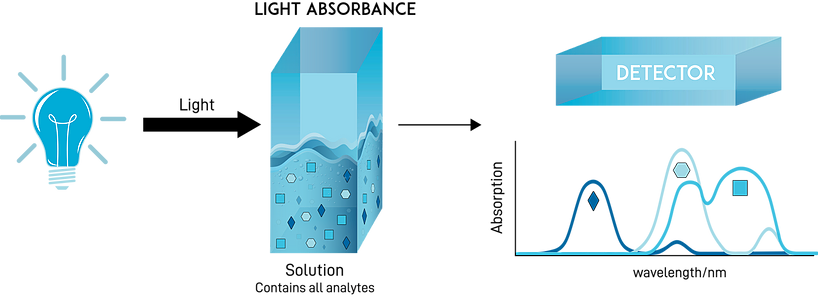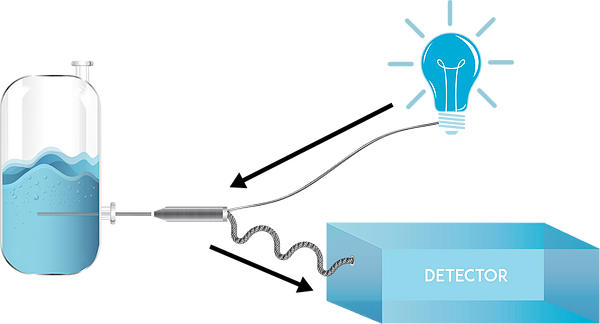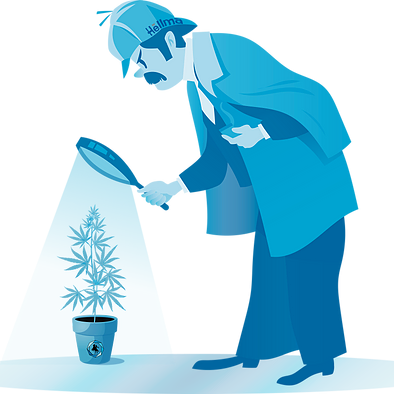**Please note this article is part of a larger series that was first released in the February 2021 Monthly Playbook. If you would like to receive the complete monthly playbook you can sign up here
Cannabis Manufacturing for the 21st Century
Part 3: Spectroscopy & Online Process Control for Cannabinoid Manufacturing
Spectroscopy is an analytical tool that started as a qualitative, identification method. However, it soon became apparent that the data can also provide quantitative insights.
Spectroscopy is the measurement of the interaction of electromagnetic (EM) radiation with matter. Visible (Vis) light and heat (infrared/IR light) are the most well-known forms of radiation, but it also includes gamma rays, x-rays, ultraviolet light, microwaves, and radio waves. Each of these types are differentiated by the amount of energy they possess. Ultraviolet light has more energy than visible light, which is one of the reasons it can cause sunburns, skin cancer, and eye damage. For the purposes of spectroscopy, the amount of energy is often denoted in units of wavelength.
A typical seeing person will qualitatively use spectroscopy everyday as they perceive the colors of different objects. Spectroscopic instrumentation allows a user to precisely quantify these observations. For example, branding colors such as Coca-Cola’s or Tiffany & Co.’s have exact colors that are created using specific mixtures of dyes. Online analysis can monitor the creation of the dye during its formulation and blending to ensure that not only is it the right color mixture every single time, but also at every location the dye is manufactured.
SPECTROSCOPY SCHEMATIC

Many spectroscopic instruments utilizes wide-spectrum light that has its broad range of wavelengths physically spread out by an optical component, such as how a prism creates a rainbow of colors. Once the different wavelengths are spaced out, you can place an array of detectors to quantitatively monitor the amount of light at each wavelength. When the light hits a molecule, the two can interact and the molecule can absorb some of the light. Most optical spectroscopies rely on the absorption or transmission of light by a sample and, in general, this absorption of UV, Vis, or IR is non-destructive. [1] The detectors monitor this change (See Figure 1).
With advances in technology, data can often be gathered in milliseconds. Quantitative information is possible because there is a strong proportional connection between the concentration of the chemicals of interest and the amount of light absorbed. The main advantages of spectroscopy is that it is a quick, cost effective, and passive technique that can provide both qualitative and quantitative analyses.
Process tank with an integrated
spectroscopic Solution Process Tank

UV-Vis, near-IR, and mid-IR spectroscopies all rely on the transmission/absorption of light at certain wavelengths. UV-Vis spectroscopy works with the excitement of electrons. The spectra tend to have few features that can cover several hundred nanometers. Near-IR and mid-IR work with the excitation of the vibrations of the atoms within the molecule. The absorption of light in the near- and mid-IR ranges causes numerous features that are usually not as broad as UV-VIS spectral features. The combination of all the features are unique to the molecule. Thus, vibrational spectroscopy can be extraordinarily useful for identifications. [1]
A mix of chemical species can create a matrix with overlapping spectral features. Untangling the intertwined data often requires expertise and numerous hours to create a statistical model that can identify and quantify the product(s) of interest. Software uses the model to quickly covert raw data/spectra into useful information such as the identities of the chemicals in the matrix and their concentrations. Using this data, spectroscopy can be the analytical tool for both qualitative and quantitative checks. For example, a quick check of the amount of moisture in a sample. It can also check a reaction’s progress by monitoring the concentrations of the reactants, intermediates, and/or products.
In the real world, methods exist for incorporating these analytical tools directly into a reactor or pipeline to measure the “sample” directly in the process continuously and in real-time (see Figure 2). This saves both the time and necessity of physically taking samples, both of which can cost a chemical plant millions of dollars. It also allows real-time monitoring of a process where it can be immediately apparent if something unwanted is occurring so that corrective steps can be taken. Beyond the value of instant insight, advanced process sensors also give the benefit of big data aggregation, where additional efficiencies and optimizations can be gained over time.
Outside of the chemical industry, spectroscopy is used for a multitude of applications. An example is the aforementioned measurement of color. Spectroscopy is also widely used in the pharmaceutical industry to measure the various steps of the Active Pharmaceutical Ingredient (API) creation. In the world of forensics, spectroscopy is often used in tandem with other methods to help identify unknown compounds, allowing for a strong case file to be built. In the cannabis industry, spectroscopy has already been implemented to quickly determine the CBD and THC levels [2] as well as moisture % and water activity in dried flower [3].
In the next installment of this series, we will cover the chemical difficulties of cannabis.
References:
- D. a. Skoog, F. J. Holler and T. A. Nieman, Principles of Instrumental Analysis, Orlando: Saunders College Publishing, 1998.
- Purpl Scientific, “Validation of the Purple Pro for Flower Potency Measurement,” May 2019. [Online]. Available: https://www.purplscientific.com/validation-of-the-purpl-pro-for-flower-potency-measurement/.
- Purpl Scientific, “Validation of the Purpl Pro + H2O Pack for Cannabis Water Measurement,” 2020 July. [Online]. Available: https://www.purplscientific.com/validation-of-the-purpl-pro-h2o-pack-for-cannabis-watermeasurement/.


